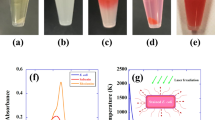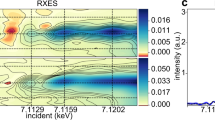Abstract
IN an attempt to shorten exposures in the ultraviolet irradiation of polymers, we have used as light sources high-intensity flash discharge lamps, described by Murphy and Edgerton1, which have been used extensively in flash spectroscopy2–4 and flash photolysis5,6. The lamps used were similar to Christie and Porter's fused silica spiral lamp No. III7 and usually were flashed with 648 µf. at 4,000 V. (5,184 j.). Each flash lasted about three milliseconds, and by uranyl oxalate actinometry8 was shown to yield 9.6 × 1019 quanta in the 2000–4900 A. region. The polymers were placed approximately along the axis of the lamp coil, either in fused silica or ‘Pyrex’ glass test-tubes, and were irradiated in air, streaming nitrogen, or in vacuo. In several polyethylenes, polystyrene, polyethylene terephthalate, polyiso-butylene, 6-10 nylon, polyvinylchloride, polytetra-fluoroethylene, regenerated cellulose and cellulose acetate, we found that, in addition to some minor homogeneous photolysis, a single flash caused violent heterogeneous decompositions within the polymer matrices. These decompositions usually were accompanied by a sharp report, the formation of gas bubbles and carbon spots within the polymer, and the deposition of fluorescent (under mild excitation by 3000–4000 A. radiation) substances near centres of decomposition. These heterogeneous decompositions do not seem to depend on the chemical properties of the polymers but rather on the presence of particulate impurities within the polymer matrices. This is shown by: (1) the wide spatial separations among decomposed areas (0.5–5 mm.); (2) the transparency of many of the polymers in the wave-length region used; (3) the reproducibility of the decompositions when certain particulate contaminants are added to the polymers before irradiating; and (4) the fact that clean polyethylene taken directly from a polymerization reactor (this polyethylene was kindly supplied by Dr. S. W. Hawkins of Imperial Chemical Industries, Ltd.) undergoes very much less decomposition than polyethylenes that presumably have become contaminated during normal processing.
This is a preview of subscription content, access via your institution
Access options
Subscribe to this journal
Receive 51 print issues and online access
$199.00 per year
only $3.90 per issue
Buy this article
- Purchase on Springer Link
- Instant access to full article PDF
Prices may be subject to local taxes which are calculated during checkout
Similar content being viewed by others
References
Murphy, P. M., and Edgerton, H. E., J. App. Phys., 12, 848 (1941).
Porter, G., Proc. Roy. Soc., A, 200, 284 (1950).
Herzberg, G., and Ramsay, D. A., J. Chem. Phys., 20, 347 (1952).
Marshall, R., and Davidson, N., J. Chem. Phys., 21, 2086 (1953).
Knox, K., Norrish, R. G. W., and Porter, G., J. Chem. Soc., 1477 (1952).
Kahn, M. A., Norrish, R. G. W., and Porter, G., Proc. Roy. Soc., A, 219, 312 (1953).
Christie, M. I., and Porter, G., Proc. Roy. Soc., A, 212, 390 (1952).
Forbes, G. S., and Heidt, L. J., J. Amer. Chem. Soc., 56, 2363 (1934).
Sun, K. H., Modern Plastics, 32, No. 1, 141 (1954).
Winslow, F. H., Baker, W. O., Pape, N. R., and Matreyek, W., J. Polymer Sci., 16, 101 (1955).
Author information
Authors and Affiliations
Rights and permissions
About this article
Cite this article
LUNDBERG, J., NELSON, L. High-Intensity Flash Irradiation of Polymers. Nature 179, 367–368 (1957). https://doi.org/10.1038/179367b0
Issue Date:
DOI: https://doi.org/10.1038/179367b0
This article is cited by
Comments
By submitting a comment you agree to abide by our Terms and Community Guidelines. If you find something abusive or that does not comply with our terms or guidelines please flag it as inappropriate.



